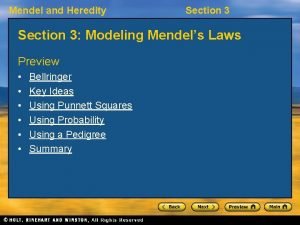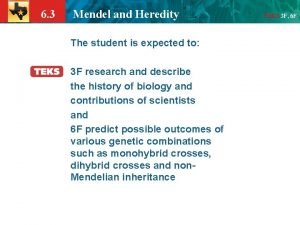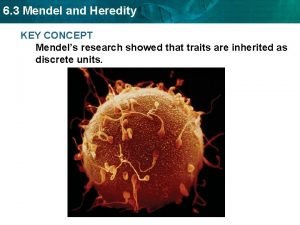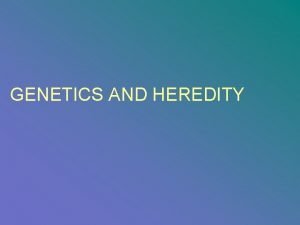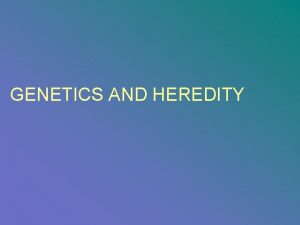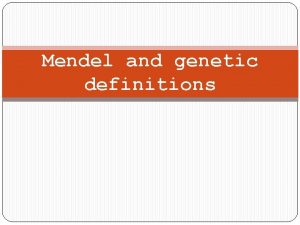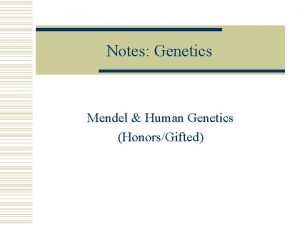Mendel and Genetics Genetics study of heredity Heredity










- Slides: 10

Mendel and Genetics • Genetics – study of heredity. • Heredity – set of characteristics passed from parent to child. • Gregor Mendel – Austrian monk (1822), high school teacher and gardener. • Bred pea plants and observed their patterns of inheritance. • “Father of Genetics” http: //anthro. palomar. edu/mendel/ mendel_1. htm

What Mendel did… • Took plants true breeding (if self-pollinated, would make identical offspring) and prevented self-pollination. • Crossed parent plants (P generation) with different characteristics to look at the offspring (F 1 generation) – Seed shape, seed color, seed coat color, pod shape, pod color, flower position, and plant height. • These offspring were called hybrids.

Warm up: Definitions • Dominant – trait expressed, Capital letter (ex “B”) • Recessive – trait masked, lowercase letter (ex “b”) • Heterozygous – 1 dominant allele, 1 recessive allele, called Hybrids or Carriers (ex “Bb”) – Hybrids – offspring that are the result of two genetically different parents • Homozygous – 2 identical alleles, called true breeding (ex “BB” or “bb”) – Purebreds – offspring that are the result of two genetically similar parents • Phenotype – physical characteristic or trait (ex tall) • Genotype – genetic makeup of the chromosome itself. (BB, Bb, or bb) • Test Cross - The crossing of an organism, with an unknown genotype, to a homozygous recessive organism (tester).

What Mendel found out… 4 conclusions • 1 st conclusion: Biological inheritance is determined by factors passed from 1 generation to the next (genes) and had contrasting forms (alleles). The Principle of Unit Characters states that individuals pass information on as individual traits. • 2 nd Conclusion: Principle of Dominance – some alleles are dominant and others are recessive. An organism with a dominant allele for a particular form of a trait will always exhibit that form of the trait.

Why are there fewer white hamsters? (Which color is dominant? Which is recessive? )

Law of Segregation • Mendel wondered: “Where did the recessive alleles go? ” • Crossed the F 1 plants with each other and looked at their offspring. • F 2 generation showed ¼ of the plants had recessive alleles. • States that each unit character separates into a different sex cell.

Remember Meiosis? • In Meiosis, alleles separate into eggs and sperm. (23) • Alleles: Versions of a particular trait. • 3 rd Conclusion: Law of Segregation- When flowers produce gametes, the two alleles segregate from each other so that each gamete carries only 1 copy of each gene. • The reunite in offspring in homologous chromosomes. (46) • HC: Chromosomes that contain the same genes for the same traits. – One from mother (23) – One from father (23)

• Alleles segregate at random. • 4 th Conclusion: The Principle of Independent Assortment - states that genes segregate according to chance. • Gene combinations that might result from a genetic cross can be determined by a Punnett Square. • PS: Predict and compare the genetic variation that result from a genetic cross. – One trait: Monohybrid cross – Two traits: Dihybrid Cross – Three traits: Trihybrid cross Genetics is Probability

• With homozygous recessive phenotypes, you can easily determine the genotype (e. g. both small letters like bb or zz) • However, the phenotype for Homozygous Dominant (BB and ZZ) and Heterozygous Dominant (Bb and Zz) are the same. • How do you determine this genotype? • A test cross is performed when you cross an unknown dominant phenotype with a known recessive phenotype and study the offspring. – If all offspring show the dominant phenotype, then it is homozygous dominant genotype. – If any (just one!) of the offspring show the dominant phenotype, then it is heterozygous dominant genotype. Test Crosses

Your Turn! • In pea plants, spherical seeds (S) are dominant to dented seeds (s). In a genetic cross of two plants that are heterozygous for the seed shape trait, what fraction of the offspring should have spherical seeds? ______ • To identify the genotype of yellow-seeded pea plants as either homozygous dominant (YY) or heterozygous (Yy), you could do a test cross with plants of genotype _______

